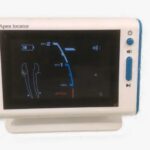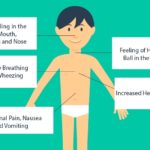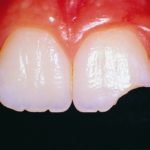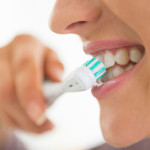Uncategorized
Cheap versus “expensive” endodontic treatment- is there any difference?
High quality endodontic treatment- how can I find out ?
Endodontic treatment, commonly known as a root canal, is a dental procedure aimed at saving a damaged or infected tooth. Quality endodontic treatment is crucial not only for relieving pain and preserving the natural tooth but also for ensuring long-term oral health. This article explores the key elements that contribute to achieving excellence in endodontic care.
⦁ Accurate Diagnosis performed by a specialist:
Quality endodontic treatment begins with an accurate diagnosis. Modern diagnostic tools, such as digital radiography and 3D cbct imaging techniques, enable endodontists to thoroughly assess the tooth’s internal structure, identify the root canal system’s complexities which can be very challenging in several anatomic conditions and detect any signs of infection or inflammation. A precise diagnosis lays the foundation for effective treatment planning and a succesfull result.
⦁ Patient Communication and Education:
Effective communication with patients is a vital aspect of quality endodontic care. Dentists should take the time to explain the diagnosis, the recommended treatment plan, and potential alternatives to patients. Educating patients about the importance of endodontic treatment, dispelling myths, and addressing concerns contribute to informed decision-making and patient cooperation throughout the process.
⦁ Skillful and Experienced Specialists:
The success of endodontic treatment relies heavily on the skill and experience of the practitioner. Postgraduated Endodontists, who specialize in root canal procedures, possess advanced training and expertise in managing complex cases. Their knowledge and experience using the latest techniques and technologies ensures that patients receive the best possible care.
⦁ Advanced Technology and Techniques:
Quality endodontic treatment benefits greatly from the incorporation of advanced technology and techniques. Innovations such as rotary instruments, apex locators, and dental lasers enhance the precision and efficiency of root canal procedures. Additionally, the use of magnification tools, such as dental microscopes like we are using in our office, allows practitioners to visualize and detect hidden surface structures of the tooths root canal system.
⦁ Aseptic Technique and Infection Control:
Maintaining a sterile environment is essential during endodontic procedures to prevent the introduction or spread of infections. Strict adherence to aseptic techniques and infection control protocols helps ensure patient safety and the success of the treatment. Proper sterilization of instruments, use of disposable materials, and a clean treatment environment are fundamental aspects of quality care.
⦁ Thorough Cleaning and Shaping of the Root Canal:
The core of endodontic treatment involves cleaning and shaping the root canal system to remove infected or damaged tissue. Thorough debridement, using specialized instruments, ensures the elimination of bacteria and debris. Adequate isolation of the root canal system with rubber dam to avoid a contamination of the root canal system is a major factor to ensure a success of the treatment. Adequate shaping of the canal facilitates effective irrigation and promotes optimal filling during the subsequent obturation phase.
⦁ Three-Dimensional Obturation using the latest sealer technology:
Obturation, the process of filling the cleaned and shaped root canal, is a very critical step in preventing reinfection and therefore securing the longtermsucces of the treatment. Three-dimensional obturation, achieved through the use of biocompatible gutta-percha in combination with bioceramic sealer, ensures a tight, non shrinking seal and reduces the risk of bacterial re-entry close to 0.
⦁ Post-treatment Restoration:
Following successful endodontic treatment, restoring the tooth to its full function is crucial. Collaboration between endodontists and to our prosthodontic department ensures that the final restoration, complements the endodontic work and provides long-lasting support for the tooth.
Conclusion:
Quality endodontic treatment is a multifaceted process that demands precision, expertise, and attention to detail. By prioritizing accurate diagnosis, effective communication, skilled practitioners, advanced technology, infection control, thorough cleaning and shaping, three-dimensional obturation, and post-treatment restoration, dental professionals can deliver optimal care, preserving natural teeth and promoting long-term oral health. Patients should actively participate in their oral care journey by seeking Qualified professionals and staying informed about the importance of Quality endodontic treatment.
Covid 19 & dentistry-safety in the dental office
Hygiene & COVID In Dentistry

What is COVID?
COVID-19 is a newly discovered infectious virus that causes corona disease. It causes mild to severe acute respiratory syndromes SARS. These respiratory illnesses can lead to severe consequences if not taken care of. COVID-19 is thought to be prevalent in older, immune-compromised, or patients with other underlying systemic diseases such as diabetes, cardiovascular, respiratory diseases, etc.
Is the coronavirus airborne?

The World Health Organization (WHO) says that the evidence is not compelling, but scientists warn that gathering sufficient data could take years and cost lives. Health officials say the virus is transported only through droplets that are coughed or sneezed out – either directly, or on objects. But some scientists say there is preliminary evidence that airborne transmission – in which the disease spreads in the much smaller particles from exhaled air, known as aerosols – is occurring, and that precautions, such as increasing ventilation indoors, should be recommended to reduce the risk of infection.
In a scientific brief posted to its website on 27 March, 2020, the WHO said that there is no sufficient evidence to suggest that SARS-CoV-2 is airborne, except in a handful of medical contexts, such as when intubating an infected person.
How can it spread through surfaces?
The CDC believes that the preliminary spread of the virus is from person-to-person; specially, those in close contact (within 6 feet) and through respiratory droplets expelled by a person through coughing or sneezing. However, the CDC states that it may be possible for a person to become infected by touching a surface or object contaminated with the virus and then touching their mouth, nose, or possibly their eyes.
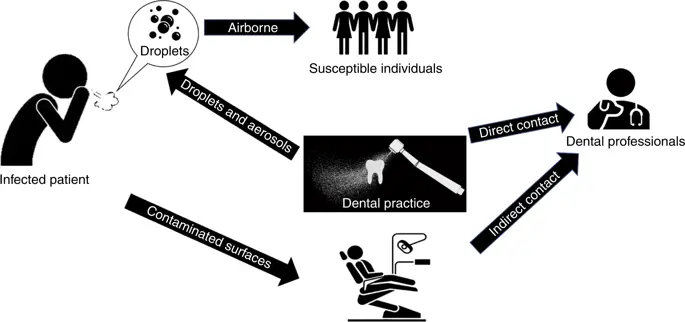
How COVID spread can be prevented in dental offices?
The dental profession is at particularly at risk, due to the possibility of aerosols produced by saliva droplets. These droplets can be inhaled, come into contact with skin or mucous membranes, and/or lodge on the surfaces of the dental office or other materials used during the dental appointment. In, addition to the infected patient’s cough and breathing, dental devices such as high –speed dental handpiece uses high-speed gas to drive the turbine to rotate at high speed and work with running water. When dental devices work in the patient’s saliva or even blood will be generated. Particles of droplets and aerosols are small enough to stay airborne for an extended period before they settle on environmental surfaces or enter the respiratory tract. A dental professional’s frequent direct or indirect contact with human fluids, patient materials and contaminated dental instruments or environmental surfaces makes a possible route to the spread of viruses.
Usage of DISINFECTION MATERIALS at Tooth & Go:
Tooth & Go is one of the most reputed dental clinic which is located in Paranaque in the south of Manila, the capital of the Philippines. In the situation of COVID-19, at Tooth & Go, we strictly follow CDC recommend standard precautionary measures for every patient every day. All the precautionary measures and steps that we take during our dental procedures reduce and decrease the risk of transmitting this virus to the patients and to our dental health care practitioners.

Some of the new equipment is installed: to prevent the spread of infection and cross infections. We installed the aerosol suction machine in our clinic. Extra-oral aerosol suction machine absorbs rapidly the aerosol particles, bacterial droplets, blood, virus generated during the treatment process to prevent dentist-patient infection and provide a safe and healthy environment for both dentists and patients. In our clinic, we always conscious of having a healthy environment during treatment procedures. As we know in the current situation of COVID, we all are now too much worry about the risk of infections than before. That’s why we are using the aerosol suction machine in our clinic.
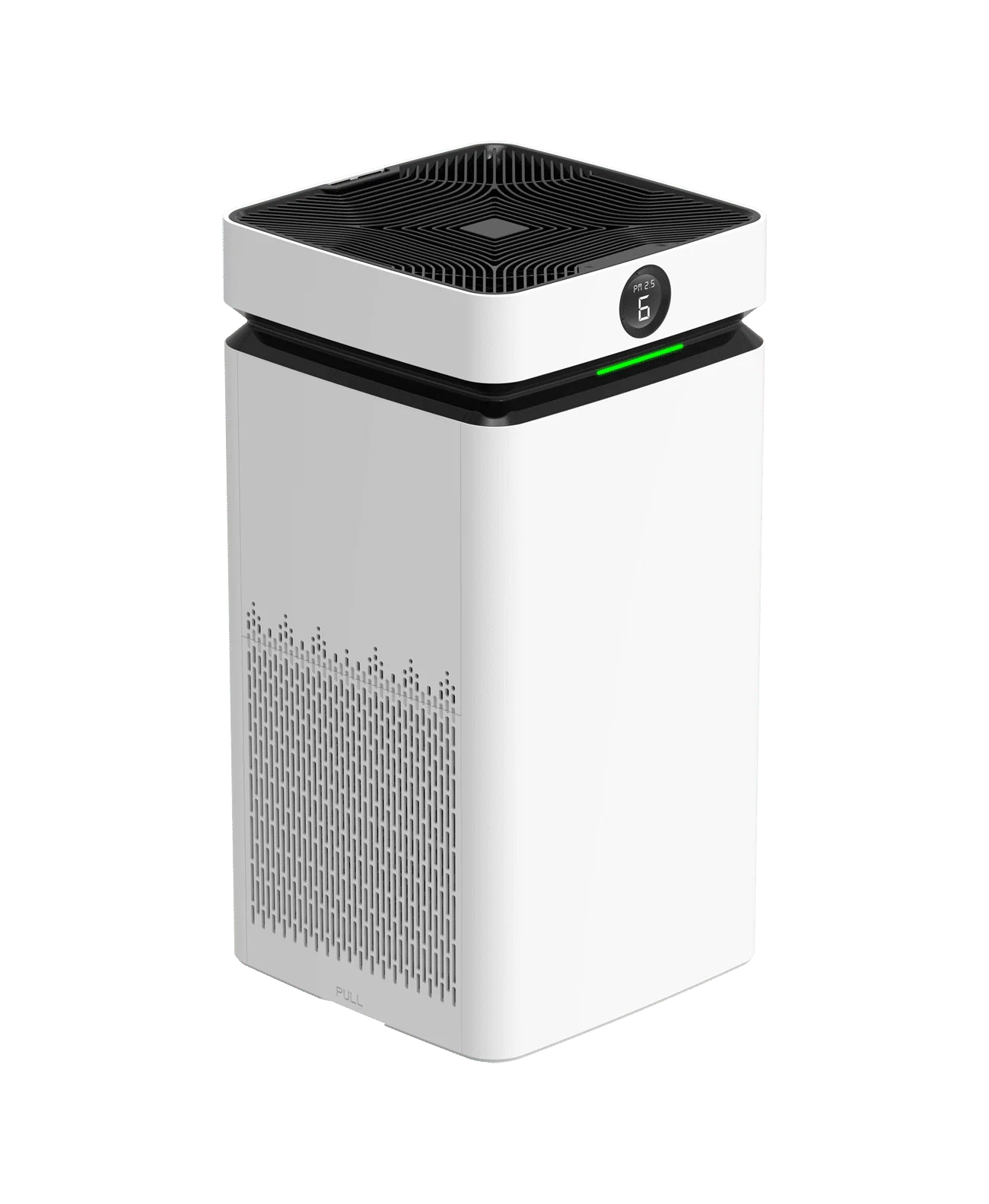
Aerosol suction: Power driven instruments usually produce aerosols and spatter, these aerosols and spatter may contain pathogenic microorganisms, injurious to health. Aerosol suction is a great machine that efficiently removes all the aerosols and spatter produced during dental procedures. It is a great modern way to protect the patients and dental staff from contamination.

We are using surface disinfection materials: Surface disinfection is a method to inactivate pathogens on inanimate surfaces. We are using effective and strict surface disinfection materials as a preventive step to keep the dental operatory safe and clean before setting a patient on a dental chair and after the treatment is completed. We are regularly using the surface disinfection materials all work surfaces where clinical care or decontamination is carried out with EPA registered intermediate viral pathogen disinfectant.

We are using tube disinfection materials: The dental unit is connected to the water systems. The water lines within the dental unit become saturated with bio-film and oral microorganisms and may enter this system during dental procedures. We all the dental practitioners of Tooth & Go , are thoroughly cleaning all the suction lines chemically with the help of tube disinfectants to remove all the bio –film , regularly before and after each patient of the treatment is done.
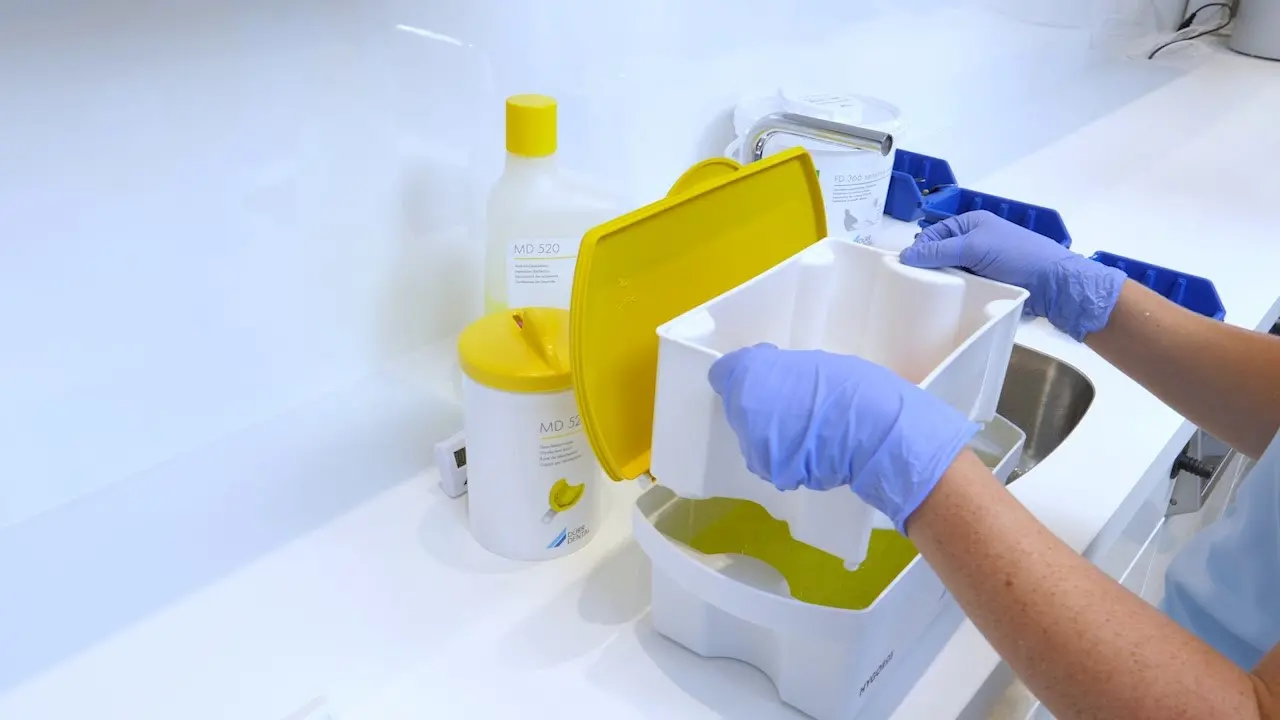
We are using also impression disinfection materials: Dental impressions are a common source for transmission of infection between dental clinic and dental labs. Dental impressions can be cross-contaminated by patient’s saliva and blood, which then cross-infect the dental casts poured from the impressions. Disinfection of dental impressions is an essential that aims to protect dental personnel, who handle impressions or casts, against exposure to disease brought about by contact with microorganisms. We always use chair-side disinfection of impressions most commonly with sodium hypochlorite to avoid laboratory sepsis.

Mouth-rinses prior dental treatment: A preprocedural mouth rinse is used for the purpose of reducing the salivary load of oral microbes, which can be spread through spatter or aerosols produced by power-driven instruments during procedures.

Face shields: A face shield, an item of personal protective equipment (PPE), aims to protect the wearer’s entire face (or part of it) from hazards such as flying objects and debris chemical splashes, or potentially infectious materials.

Eye shield: Transmission is most likely through the mouth or nose but the conjunctiva makes the eye another possible transmission site for COVID-19. Without eye protection – such as glasses, goggles or a face shield, eyes will not be guarded from coronavirus. We always concern about face shield with eye protection to prevent transmission of this virus.

Face mask: The CDC recommends that a surgical mask and eye protection with solid side shields or a face shield should be worn to protect mucous membranes of the eyes, nose , and mouth during dental procedures likely to generate splashing or spattering of blood or other body fluids. At first of this article, we mentioned that we are strictly follow the rules of CDC for the protection of our dental clinic.

Autoclave: Autoclave is a machine used to sterilize the instruments by subjecting them to pressurized saturated steam at 121 degree for around 15-20 minutes. In dental practice, sterilization is most important part and it protects the dentists as well as the whole team of the clinic from the growth of microorganisms.

Hand Hygiene: Reinforcement for good hand hygiene is of the utmost important. Especially, hand hygiene in dental practice is the most important part of the infection control process to reduce the risk of transmitting microorganisms from provider to patient. Hand washing with soap and water remains a sensible strategy for hand hygiene in non-health care settings and is recommended by CDC. We all members of the clinic are strictly conscious of hand hygiene.

Rubber dam: The use of rubber dams can significantly minimize the production of saliva and blood contaminated aerosol or spatter, particularly in cases when high speed hand pieces and dental ultrasonic devices are used. It has been reported that the use of rubber dam could significantly reduce airborne particles in the 3 foot diameter of the operational field by 70%.

Package seals for dental tools: The importance of sealing in the dental practice is also very important part. The importance of bagging in the dental practice, after washing and decontamination phase, each single instrument and device must be bagged and each package properly sealed. Once bagging is over, sealing then completes the packing phase and is essential for an effective passage in autoclave as well as to preserve the sterility of the autoclaved instruments until they are to be used. In our clinic, we follow all the necessary packing procedure carefully.
COVID-19 is the first readily transmissible infectious disease that the global community has confronted in the new millennium. The participants in dental practice expose to tremendous risk of Covid-19 infection due to the face to face communication. According to medical research reports, dentists are eight times more at risk of contracting COVID-19 infections. We, the whole team of the, ‘Tooth & Go Dental Clinic’ always try our best to give the best services ever to our patients in this time. We provide safety and security of both the patients and our dental health care practitioners, by following the maintenance of standard precautions.
Anaphylactic shock- what is this and how can it be treated?
What is an Anaphylactic shock and how to treat it?
An anaphylactic shock is immunsystem related, meaning its caused by an overwhelming allergic reaction. For example Penicillin or a local anesthetic agent can act as allergens causing this type of reaction.
The allergen can enter the body by ingestion, inhaling or transdermal.
Ige, which are antibodies produced by plasmacells after an allergen triggered the production in an earlier stage. If an allergen enters again the body, it binds to the Ige located on the mastcells.
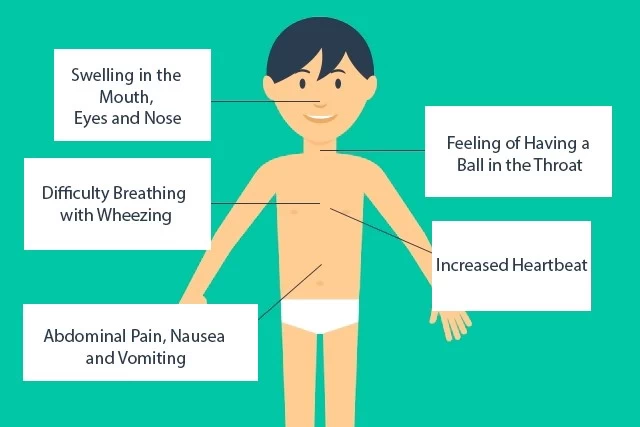
Once bind, the mastcells are releasing histamins which are triggering the following functions:
-Bronchoconstruction(shortness of breath)
-Central Vasodilatation
-Itching
-Constriction of periphere blood vessels
An anaphylactoid shock is non immunsystem related, that means the shock is triggered by substances which are affecting by substances like radiographic contrast substances, drugs..
This substances are damaging the membrane of mastcells and caausing therefore the release of histamins. In that way they are not Ige related and can occur even the indidviduum hasnt been exposed before by any substance which triggers this reaction.
How to treat an anaphylactic shock?
-Removal of the allergen
-Supply of Oxygen
-Trendlenburg position(resting of the individuum on the floor with elevated legs to allow a bettter blood supply of brain and cardiac system)
-First Line drug is Epinephrine(Epi Pen injection)
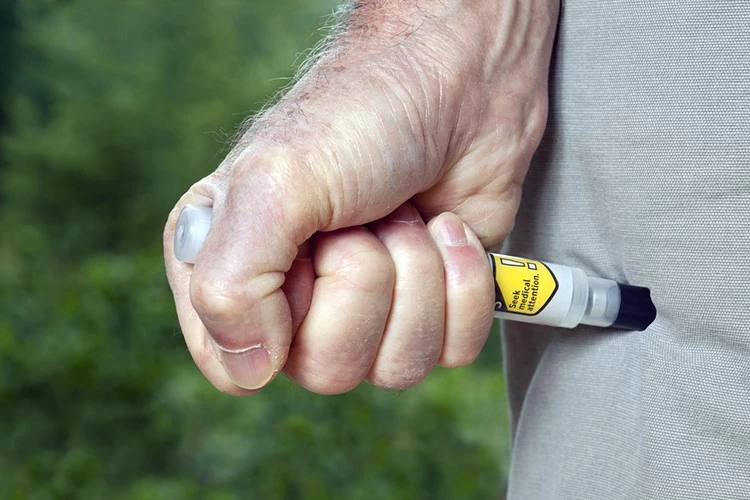
-Second line :
-Iv fluids
-Albuterol
-Anthistiamins wherein we have to differentiate in between first generation antihistamins (H1-Diphenhydramine-can penetrate blood-bran barrier) and (H2-Ranitidine-cant penetrate blood-brain barrier)
-Corticosteroids
-Stay and monitor the patient(biphasic anaphylaxis)
Dental emergencies and their symptoms
Most Common Dental Emergencies And Their Symptoms
Everyone has experienced some type of many dental emergencies at least once in their lives. These are serious situations which always require the attention of a professional. Remember, whatever you’re experiencing, make sure to call the dentist first. Don’t try out things by yourself, especially if these are not recommended by a professional. You definitely don’t want to cause any further damage. Below we listed the most common dental emergencies and tips on how to temporarily deal with them.
Chipped And Fractured Teeth
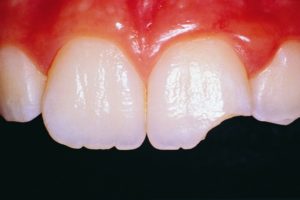 Chipped and broken teeth are a very common dental emergency. These often happen during accidents of all types. It can be a car accident, fall from a bike, a trauma with some object and a whole range of other situations. They can also appear at all ages, but are much more frequent among young kids who are always active. Once this happens patients usually have no idea how urgent it is or how they should take care of it. First of all, cracked teeth are not always that obvious such as broken. It can literally be the smallest piece that you won’t even notice, or experience any symptoms. It is much more noticeable when it happens in the frontal region.
Chipped and broken teeth are a very common dental emergency. These often happen during accidents of all types. It can be a car accident, fall from a bike, a trauma with some object and a whole range of other situations. They can also appear at all ages, but are much more frequent among young kids who are always active. Once this happens patients usually have no idea how urgent it is or how they should take care of it. First of all, cracked teeth are not always that obvious such as broken. It can literally be the smallest piece that you won’t even notice, or experience any symptoms. It is much more noticeable when it happens in the frontal region.
How To Deal With It
Of course, the main thing you have to keep in mind is to visit the dentist right away. Since both of these situations are considered, time is of the essence. There are many varieties of chipped and broken teeth, so each one is treated in a different way by the dentist. Also, remember to find and keep the broken parts of the tooth. In the meantime, there are a few things you can do to ease the pain. Start with getting a pain reliever that you have. Make sure that you also rinse your mouth with warm water and remove all the broken pieces on the side. You can ease the swelling with ice on the side where it happened. If there is bleeding, apply pressure with a piece of gauze.
 Toothache
Toothache
We all know how awful it is when a tooth hurts. There are several different dental conditions that can lead to a toothache. It can wake you up in the middle of the night, or strike you at the office. The pain makes a toothache a dental emergency.
Also the characteristics can vary, starting with a very short and throbbing pain, or a constant unbearable one. Some of the reasons include caries, gum disease, chipped teeth, and more. This unfortunate situation can prevent you from doing your everyday activities or lose sleep at night. You can even experience difficulties while eating, fever, working and so much more.
How To Deal With It
Since no one likes pain, this is an emergency situation that you have to take seriously. The best solution is an immediate visit to the dental office. In most cases painkillers only help you deal with it for a very short amount of time. So the best advice is to start by rinsing the mouth. If there is swelling, apply cold on the outside. Aside from this there is not much else you can do until you go to the dentist. Don’t ever try to put a painkiller on the gum where the tooth hurts, that can actually cause damage to the soft tissues.

Knocked Out Teeth
Knocked out teeth are a very common dental emergency together with fractured and chipped teeth. They happen as a result of an accident. This requires an immediate visit to the dentist, because time is of the essence. If you can get there as fast as possible, the dentist might even be able to save your tooth or teeth. The signs of knocked out teeth are very obvious. You will notice that a toot is missing and is not located in the mouth anymore. There will be bleeding, pain and it can often come together with lacerations, cuts, and other visible injuries depending on the cause.
How To Deal With It
Right after the accident happens, the most important thing is to check the vitals of the patient and quickly check for other injuries that can be even more urgent than the one in the mouth. If a knocked out tooth is the only injury, you have to find it. It might be out of the mouth, or still somewhere inside. Check under the tongue, in the cheek area and once you do you should only touch it at the crown. At all costs avoid touching the root. The roots contain cells and fibers which are very gentle and can help the dentist reattach the tooth in the socket.
After you’ve found the tooth, take it by the crown and find the best place to store it. It can be milk, the inside of the mouth under the tongue or inside the cheek, or if you can’t find any of these, saline and water will do the job. Don’t scrub the tooth. If there is an option, try putting the tooth back in the socket. In the meantime, go to a dental office where you’ll be taken care of by professionals. Time is the most important factor in cases such as this one. The longer the tooth is outside of the pocket, the smaller the chances are that it will be replanted in the socket.

Jaw Pain
Jaw pain can be caused by a variety of factors. The most urgent one is a broken jaw. It can happen during a fall, accident, or a strong force affecting the jaw bone. Most patients don’t take jaw pain seriously. A broken jaw is one of the most important dental emergencies that require instant attention. Other types can even come from the joints. Either way, the first thing you need to do is a call and visit a dentist.
How To Deal With It
Once jaw pain happens, you should stay away from solid food and call your dentist. There is not much you can do. If there is actual and obvious swelling, you can treat it with ice.
A Crown Or Restoration Has Come Off
This usually happens with temporary restorations, but that doesn’t mean that it’s not an emergency. No matter if it’s a permanent or temporary, a crown that has come off requires dental attention as soon as possible. The same thing applies to dental bridges, fillings, and all other restorations. Once you notice that it has happened, try reaching your dentist and let him know. They are aware that they should give you an appointment the same day if possible. It can be accompanied by pain, hypersensitivity and more.
How To Deal With It
There is nothing you can do, except for going to the dental office. You should definitely avoid chewing on that side, because you can cause damage to the tooth. If you are not able to go to the dentist the same day. try putting back the crown on with an over the counter cement. Other options are Vaseline, denture adhesives and more.
Soft Tissue Injuries
The mouth is made of soft tissues that are often injured. It is another one of the dental emergencies you have to take care of right away. This is a large group of injuries that include cuts, rips, wounds, lacerations, bleeding and more. They can happen to the mouth, tongue, cheeks, lips and every other soft tissue that takes a part in building the oral cavity. Among the many symptoms you will notice pain, bleeding, discomfort, inflammation
How To Deal With It
Start by rinsing your mouth with water. Make sure that you clean the area where the injury happened. If there is bleeding, you’ll have to apply pressure with gauze to stop it. In this case it is recommended to wash the mouth with a very mild salt and water solution. Hold the pressure for about 15 minutes. If there is swelling you want to try a cold compress on the outside. The primary thing to think of is to immediately call your dentist and let them know what happened. Literally any medical facility in the nearby area will do the job if there is bleeding. Be very careful with painkillers when experiencing soft tissue injuries. Some types including aspirin are considered to be anticoagulants and will interfere with the process of stopping the bleeding.
 Damaged Braces
Damaged Braces
This is a dental emergency for an orthodontist. Dental braces are made of several parts, all of which can be damaged. Unfortunately, in most cases, the patient will not be able to solve the problem. This means an urgent visit to the dental office. Orthodontic wires can often break and cause injuries to the surrounding soft tissues. They have to be cut and replaced with a new one. Another case is loose and fallen off brackets.
How To Deal With It
Call your orthodontist and schedule a visit. In the meantime, try changing the position of the wire, so that it doesn’t hurt you. If you can’t manage to do that, cover the end with a small gauze, or any other soft fabric. Loose brackets are a much bigger problem, since you don’t own any instruments or materials that you can re-attach them with. Keep the bracket and take it with you to the orthodontist.
Objects Stuck in The Mouth
It does sound strange but a lot of patients appear to the dental office with this problem. It is very easy to get an object or even food logged in between teeth or in the gums.
How To Deal With It
At first, try removing whatever stuck with a very gentle procedure. If that doesn’t help, you can try using dental floss. When that doesn’t work either, it’s time to call the dentist. You don’t want to opt for sharp objects that you find at home because you can injure yourself even more.
Hygiene Tips
Most Important Dental Hygiene Tips You Have To Know
Having a gorgeous white smile doesn’t come without a single effort. Proper dental hygiene is the only way to achieve a healthy oral cavity. A lot of people are not educated enough on what they should be doing as a part of their regular oral hygiene. Others, simply ignore the tips they get or read. If you decide to follow the simple advice below, you will find that dental hygiene is not as complicated as you previously thought. Brushing and flossing are the two basics everyone has heard of, but do you really know how, why and when to do it? These tips will give you a very detailed look of what you should be doing to keep your oral cavity healthy at all times. It will save you both time and money. Dental procedures tend to be expensive, so why to expose yourself to additional costs, when you can prevent any conditions from happening. Check out the dental hygiene tips and start practicing them for a great mouth health.
Brush At Least Twice
 The first tip for a wonderful and healthy smile is, of course, brushing your teeth. But simply brushing them won’t always do the job. It is very important to know that you have to do it at least twice a day. What most people do is brush their teeth in the morning and at night, before going to bed. Dentists strongly advise that you should also practice this routine after every single meal in a day. The recommended time to spend on this action is at least two minutes each time. If you have trouble brushing for two minutes, you can improve that by selecting a song to listen to, or watching a video while you do it. It is as simple as that. Having clean teeth will spare you time and money. First of all, you will save up on dental restorations, which can be quite costly.
The first tip for a wonderful and healthy smile is, of course, brushing your teeth. But simply brushing them won’t always do the job. It is very important to know that you have to do it at least twice a day. What most people do is brush their teeth in the morning and at night, before going to bed. Dentists strongly advise that you should also practice this routine after every single meal in a day. The recommended time to spend on this action is at least two minutes each time. If you have trouble brushing for two minutes, you can improve that by selecting a song to listen to, or watching a video while you do it. It is as simple as that. Having clean teeth will spare you time and money. First of all, you will save up on dental restorations, which can be quite costly.
Also, you will spare yourself from scheduling visits and also painful experiences. The main reason for decay is the plaque. Plaque consists of food debris, bacteria, dead cells and more. It sticks to the surfaces of both teeth and gums. If you don’t brush teeth thoroughly, that plaque can lead to caries. The bacteria present there will create acids that damage the enamel and dentin. That is how a lot of people have decayed teeth, or some even lose theirs. Dentists say that brushing teeth at night is more important than anything else. Although most of us think that making it a habit in the morning is crucial, this is completely wrong. Going to bed with a clean mouth is definitely of primary concern. Before you go to sleep, if there is a lot of plaque left on your teeth, plus your mouth is closed, bacteria will thrive. That is why the chances of getting decay are much higher if you don’t brush at night. This doesn’t mean that you should skip the morning part.
Do It Properly
Simply brushing your teeth won’t do it. You have to make sure that you’ve mastered the right technique. Plus, another very important thing that people forget is to wash the whole mouth. Plenty of individuals out there focus on teeth, without being aware that every single inch of the mouth can store bacteria. This includes the tongue, gums, the roof, area below the tongue and more. It is especially important to explain this to young children. If they figure out the basics of a clean oral cavity they won’t have a problem with any type of oral conditions or diseases. The brushing technique is very easy to learn, all you have to do is follow the instructions. If you prefer visual aid, you can always check out a YouTube video that shows you exactly how to do it.
The first thing you have to do is to forget about brushing horizontally. This is the worst thing you can do to your teeth. Also, harsh movements are definitely a thing you don’t want to do. Place the toothbrush with the bristles at a 45-degree angle to the gum line. Once the bristles touch the surfaces of the teeth you can continue with up and down movements. That way, you completely remove the debris and food particles. Bush both the frontal, oral and occlusal surfaces. You need to get a special brush for your tongue as well.
Choose The Right Brush
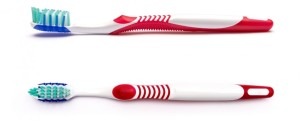 No work is done without the proper tool. The same thing goes for oral hygiene. One of the most important steps of keeping your mouth and teeth clean is choosing the right brush for you. There are different sizes, different shapes, and softness of bristles.
No work is done without the proper tool. The same thing goes for oral hygiene. One of the most important steps of keeping your mouth and teeth clean is choosing the right brush for you. There are different sizes, different shapes, and softness of bristles.
To find out more about what exactly you should use, make sure to talk to your dentist. Dental professionals are the best person to ask and get the full explanation to all your doubts. For example, if you use a brush with hard bristles, and have a bad technique, you can cause abrasion to the surfaces of the teeth. This is just one of the reasons why you should inform yourself to have the best possible oral hygiene.
Floss
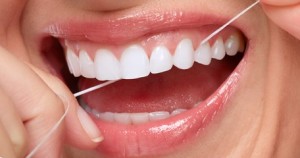 Flossing is just as important as brushing. Most people avoid doing it, and that’s where their whole routine goes wrong. Every single dentist that you’ll visit will give you the same advice- floss daily! The surfaces facing other teeth and the spaces between teeth cannot be cleaned with just brushing. That is why every single person out there has to use floss. Just like with brushes, there are many different types of floss. Using it with the proper technique will help you remove the food residue in between teeth.
Flossing is just as important as brushing. Most people avoid doing it, and that’s where their whole routine goes wrong. Every single dentist that you’ll visit will give you the same advice- floss daily! The surfaces facing other teeth and the spaces between teeth cannot be cleaned with just brushing. That is why every single person out there has to use floss. Just like with brushes, there are many different types of floss. Using it with the proper technique will help you remove the food residue in between teeth.
Caries located on those surfaces are among the most common ones, so regular flossing will definitely help you keep the whole oral cavity clean and decay-free. All you have to do is get a piece of floss with the approximate length of 20 inches. For each tooth, you have to use a clean portion of it. There are also floss holders that you can use to help you out until you learn the proper technique. This will leave both your teeth and gums perfectly clean.
Regular Dental Check-Ups
Visiting the dental office at least twice a year is crucial for good oral health. One of the most important dental hygiene tips you’ll ever receive is that you have to regularly visit your dentist. During each check-up, the dentist will let you know about the current situation of your whole oral cavity. This means every single part of it, including teeth, tongue, gums, and so much more. They will also advise you on the things you should be doing better. For example, if the dentist notices plaque, they will help you out with the brushing technique. If there is caries located on the approximal surfaces, that means you should be flossing more often. Sometimes the dentist will ask you to schedule more frequent check-ups due to certain conditions. Every single dental procedure is expensive, so why spend money when you can prevent things from happening.
Know What To Eat
 A balanced diet can have a huge effect on your oral health. There are so many foods that are good for the teeth, and many more that should not be on your shopping list. You are already aware that sugar is the worst thing you can do for your dental health. It is the primary source of food for bacteria that live in your mouth and that cause caries. They take the sugar and transform it into acids, which damage the dental substances. That is the main mechanism of how decay occurs. So, this doesn’t mean that you should completely quit foods that contain sugar. But, you should definitely be careful with the intake. Raw and hard healthy foods are always a good idea, since they stimulate the salivary flow, plus provide a mechanical cleaning of the teeth. This group includes vegetables, apples, cheese, nuts and more. Also, your diet should be rich in vitamins and minerals, since teeth are mostly made of minerals. These ingredients are beneficial for the overall health of the mouth, not only teeth. Fluoride is another mineral that you want to include in what you eat. It strongly helps in the process of remineralization of teeth. In other words, if there are initial lesions of caries, that have lost a part of their mineral content, fluoride can help to bring back the minerals and stop the process from progressing further. Avoid taking fluoride supplements without consulting your dentist first.
A balanced diet can have a huge effect on your oral health. There are so many foods that are good for the teeth, and many more that should not be on your shopping list. You are already aware that sugar is the worst thing you can do for your dental health. It is the primary source of food for bacteria that live in your mouth and that cause caries. They take the sugar and transform it into acids, which damage the dental substances. That is the main mechanism of how decay occurs. So, this doesn’t mean that you should completely quit foods that contain sugar. But, you should definitely be careful with the intake. Raw and hard healthy foods are always a good idea, since they stimulate the salivary flow, plus provide a mechanical cleaning of the teeth. This group includes vegetables, apples, cheese, nuts and more. Also, your diet should be rich in vitamins and minerals, since teeth are mostly made of minerals. These ingredients are beneficial for the overall health of the mouth, not only teeth. Fluoride is another mineral that you want to include in what you eat. It strongly helps in the process of remineralization of teeth. In other words, if there are initial lesions of caries, that have lost a part of their mineral content, fluoride can help to bring back the minerals and stop the process from progressing further. Avoid taking fluoride supplements without consulting your dentist first.
Food can be very important also if your goal is to have whiter teeth. Carrots, strawberries, oranges, broccoli, onions, and apples are just a part of the choices that can whiten teeth. When it comes to citric fruits, you should be very careful. Because of the acids, they can cause erosion and abrasion if eaten in large amounts. Sticky sweets and foods tend to stay stuck to the surfaces of teeth, so you should definitely avoid them. Make sure to always brush your teeth after a meal that contains sticky foods.
No More Soft Drinks And Alcohol
Sodas are full of sugar, which means they are no good for your oral health. They also contain phosphorus, which if you overdo it can cause damage to the dental tissues. In other words, bubbly drinks can do no good for your oral health. Dental hygiene doesn’t only include brushing and flossing. It also focuses on many other things that you should and shouldn’t do if you want to protect your mouth. Alcohol and coffee are not the best choices as well. Both of these can color your teeth and alter the natural shade. This doesn’t mean that you should completely avoid these drinks. Instead, have them in moderation, or choose to drink them with a straw. That way you avoid a direct contact between the drink and the surfaces of teeth.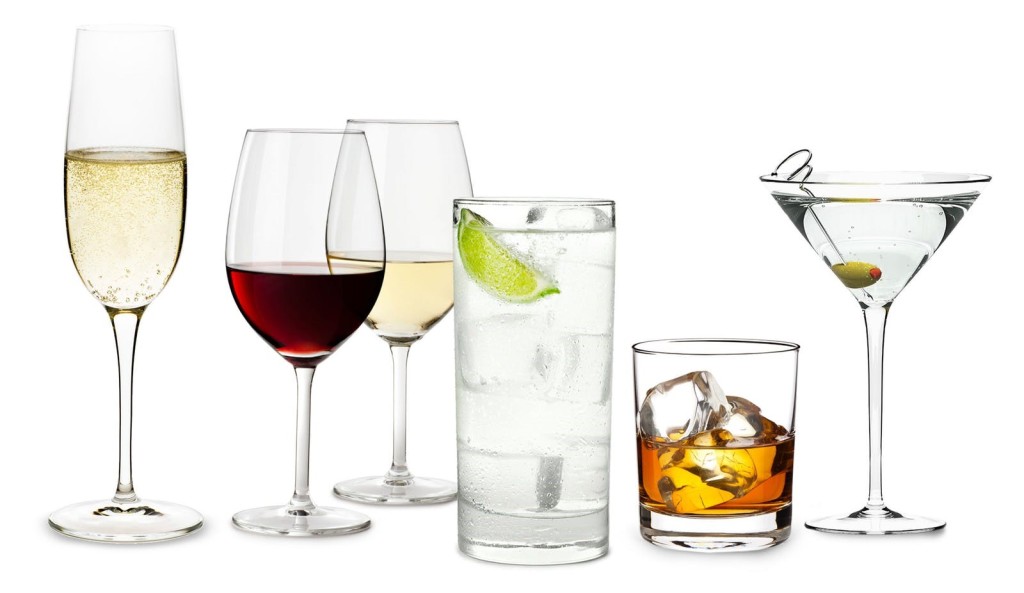
Use Mouthwash
 These days there are so many different products on the market to help you out with good oral hygiene. Just like floss, mouthwash is an essential one, every single person should own and use.
These days there are so many different products on the market to help you out with good oral hygiene. Just like floss, mouthwash is an essential one, every single person should own and use.
It is meant to provide a clean oral cavity and destroy the harmful bacteria that was not removed with brushing or flossing. It is a very helpful liquid that only improves the dental hygiene on so many levels.
It protects both the teeth and the gums. There are so many different types with different smell and function. You can choose what you need the most help with. If you have any doubts, contact your dentist and you’ll get the help that you need.
Treat Harmful Habits
There are certain habits that can really affect your oral health. We all know that drugs, alcohol, and tobacco are the worst possible habits that have a very damaging effect on your overall health. Aside from those, there are certain ones that directly damage the oral cavity. Some are thumb sucking, biting nails, tongue-thrusting, and more. Avoid opening things with your teeth. Snacking is another habit that you must deal with. This is especially important at night after you’ve brushed your teeth. Snacking on healthy things such as nuts, seeds, vegetables or fruit during the day is completely fine. But if you always opt for chips and sweets, you should definitely try and change that. If you go to sleep right after snacking, you are providing bacteria with plenty of food during the night and are exposing your teeth to potential decay.
Change And Clean Your Brush
Dentists recommend changing your toothbrush with a new one frequently. Once you notice that the bristles are curved you should immediately buy a new brush. This means that it is not brushing your teeth with the efficiency it is supposed to do it with. You don’t want to engage additional force with your hand, because you can do damage to the dental substances. Properly washing and storing the toothbrush is another moment that most people are not doing right. If you are always covering the part with the bristles with a cap, stop doing it. According to scientists, this causes bacteria to multiply even more and you are not actually protecting the brush. Rinse it very well after brushing and let it air dry. Two to three months is the period when you should buy a new toothbrush. If you notice that it’s not doing the job before that period, make sure that you change it anyway. You will notice a huge difference.
How can Sinusitis Affect Your Oral Health
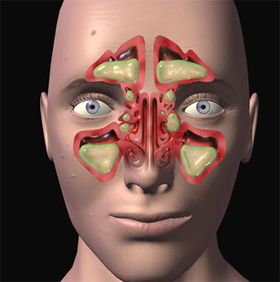 The oral and nasal cavity are very closely connected one to another. That is why a lot of conditions and diseases can be easily transferred from the mouth to the nose and the other way around. Sinuses are cavities located in the bones, that have several different functions. There are also many different sinuses located in separate bones. They are located on the bones of the skull and help with the resonance of the voice, hearing and more. All of these cavities can get inflamed, so the condition is called sinusitis. We are talking about respiratory inflammations that affect more than one system. The close anatomical connections of the digestive, respiratory and oral tracts leads to the possibility that the inflammation can spread from one place to another. Since most patients are not aware of the fact that sinusitis has a lot to do with the mouth, we are here to let you know more about this condition and the effects it has on your oral health.
The oral and nasal cavity are very closely connected one to another. That is why a lot of conditions and diseases can be easily transferred from the mouth to the nose and the other way around. Sinuses are cavities located in the bones, that have several different functions. There are also many different sinuses located in separate bones. They are located on the bones of the skull and help with the resonance of the voice, hearing and more. All of these cavities can get inflamed, so the condition is called sinusitis. We are talking about respiratory inflammations that affect more than one system. The close anatomical connections of the digestive, respiratory and oral tracts leads to the possibility that the inflammation can spread from one place to another. Since most patients are not aware of the fact that sinusitis has a lot to do with the mouth, we are here to let you know more about this condition and the effects it has on your oral health.
What Is Sinusitis?
Sinusitis, or also known as rhinosinusitis, is an inflammation or infection of the sinuses. It is closely connected to the dental health since a part of these cavities are located around the oral cavity. The symptoms can also affect the mouth and dentists are often the ones that notice signs of sinusitis. It appears with both children and adults. Treatment is needed in all of the cases, first to ease the symptoms and also to prevent further complications.
What Are The Symptoms?
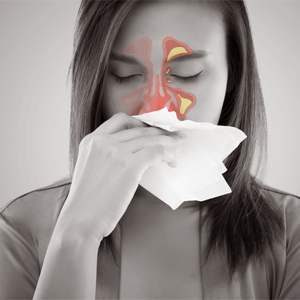 The most common symptoms of sinusitis are high fever, pain in the face area, nasal mucus, no smell sensation, intense pain or a headache, plugged nose, and more. Sometimes that pain can spread to the mouth area, cheeks, teeth, throat, ears, temporal lobes. Another very frustrating thing is the nasal congestion that leaves patients breathing on their mouth. If this condition lasts for a longer time, it can cause a dry mouth. Constantly breathing through the mouth will result with xerostomia, a faster thriving of bacteria, gum inflammation, bleeding, dry mouth, throat and more. When it comes to the mucus draining from the nose, it can have a clear color, or it can have a strange discoloration. Shades of yellow or green point out that the condition might be caused by bacteria. Coughing is another symptom that often appears, and can even persist for a longer period of time. Bad breath is present together with the dry mouth. It all depends on which sinuses are affected and how long the inflammation is present.
The most common symptoms of sinusitis are high fever, pain in the face area, nasal mucus, no smell sensation, intense pain or a headache, plugged nose, and more. Sometimes that pain can spread to the mouth area, cheeks, teeth, throat, ears, temporal lobes. Another very frustrating thing is the nasal congestion that leaves patients breathing on their mouth. If this condition lasts for a longer time, it can cause a dry mouth. Constantly breathing through the mouth will result with xerostomia, a faster thriving of bacteria, gum inflammation, bleeding, dry mouth, throat and more. When it comes to the mucus draining from the nose, it can have a clear color, or it can have a strange discoloration. Shades of yellow or green point out that the condition might be caused by bacteria. Coughing is another symptom that often appears, and can even persist for a longer period of time. Bad breath is present together with the dry mouth. It all depends on which sinuses are affected and how long the inflammation is present.
Types
Although different sinuses can be affected, the two main types of sinusitis are acute and chronic. An acute one is a type that lasts for a short amount of time, and the symptoms are taken care of. If patients leave the condition unattended, and the symptoms are only halfway treated, this may lead to a chronic sinusitis. The acute form lasts less than 4 weeks. According to doctors, if the inflammation persists for more than three months, that is when it becomes a chronic one. With this type, it is really hard to properly find a way to treat it, because in most cases it leaves several permanent changes, especially in the tissue underlining the walls of the cavities. IF those altercations happen, doctors will have a harder time treating the condition, so that is why you should always ask for help the moment you notice symptoms.
Causes
Sinusitis can be caused by many symptoms. This is considered to be a respiratory condition so the most common causes are allergies, bacterial infections, many types of irritating substances, a nasal polyp, a number of other medical conditions, respiratory infections, viral infections, deviated nasal septum and more.
Acute Sinusitis
The acute form of this respiratory condition appears usually when there is some type of viral infection in the track. It can be caused by influenza, rhinoviruses, adenoviruses and many more. With the proper treatment, the symptoms should disappear within a week. Bacterial infections caused by Haemophilus Influenzae, Streptococcus pneumoniae also appear often. This type requires a more intense and persistent treatment with the right medication. Fungal infections are rare and should be treated right away. They are connected with immunodeficiency. Tooth infection is another cause that can lead to an acute sinusitis.
Chronic Sinusitis
If the condition persists for more than three months, it is officially a chronic one. This form is divided into two large groups: with or without a polyp. Nasal polyps cause a condition called chronic hyperplastic sinusitis. It is still not completely clear if only one factor causes the hyperplasia, or if it is a combination of multiple. Some of the ones that are a part of everyday life are pollution, allergies, dust, bacterial infections and more. The form without a polyp is also a persistent one that lasts for more than three months. It all starts with the same symptoms and if not treated, it causes permanent changes in the structure of the cavities. The common factors that cause it are an untreated bacterial infection, or one that was not treated properly, frequent irritation with allergens, pollution, smoke, and more.
Sinusitis And Oral Health
What most people are not aware of is that a sinus inflammation and oral health are very closely connected. One of the main things that will surprise you, is that conditions of the teeth can lead to sinusitis. There is a sinus cavity located in the upper jaw called a maxillary sinus. The inflammation of this sinus can travel from other cavities, or it can be the primary source of inflammation and infection. This type of sinusitis is called a maxillary and can often be misdiagnosed. The same thing applies to all of the types from this condition. Although a lot of people suffer from it, doctors can mistake it for a number of other conditions.
The maxillary sinus is the largest one of them all. If it is inflamed the process can spread to all the other cavities. It is located in the back part of the upper jaw on both sides. It is above the posterior teeth, and there are cases where these teeth with the tip of their roots are even a part of the wall of the sinus. This is an easy entry point of infection, so that is why sinusitis is very important to dentistry. A detailed x-ray shows whether the apexes are close to the sinus, or they are separated with bone tissue. This is also important for dentists before they decide to extract posterior maxillary teeth.
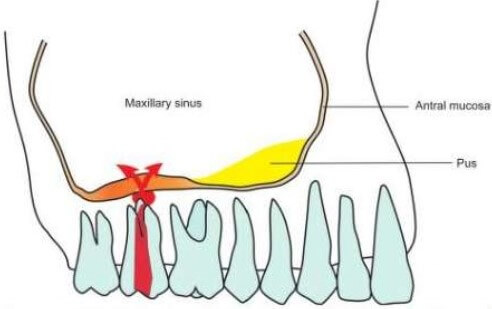
A sinusitis that is caused by a tooth infection is called an odontogenic sinusitis. In the past, research showed that a very low percentage of the cases had an odontogenic origin. Latest studies show the complete opposite. Almost 40 percent of all cases of sinusitis are somehow connected to the oral cavity. This is definitely a worrying number, so everyone should know more about how the sinuses and dental health are connected. This type of inflammation is caused by a bacterial infection. If there is a process happening at the apex of the tooth, it can easily reach the wall of the sinus, and the infection will spread inside the bone cavity. Another way to go is an extraction of a tooth, that ruptures the wall of the sinus, and leaves an open path for bacteria to get inside. Since the x-rays don’t always show the exact amount of bone between the sinus and the tooth, dentists can have a wrong impression on whether they should remove the tooth or not. If the sinus is opened after the extraction, every single dentist should take care of it, or send the patient to an oral surgeon so that the condition is treated immediately.
Symptoms of Maxillary Sinusitis
 If the opening of the maxillary sinus happens during extraction or a dental procedure, patients usually have symptoms right away. The range includes a headache and aches in the affected area, unpleasant feeling, discharge, nosebleed, circulation of air from the nose to the mouth, liquids coming out from the nose and more. All these symptoms will make patients visit the dentist once again and get the situation taken care of.
If the opening of the maxillary sinus happens during extraction or a dental procedure, patients usually have symptoms right away. The range includes a headache and aches in the affected area, unpleasant feeling, discharge, nosebleed, circulation of air from the nose to the mouth, liquids coming out from the nose and more. All these symptoms will make patients visit the dentist once again and get the situation taken care of.
Bad Breath
This is a symptom that accompanies all types of sinusitis if they persist for a longer period of time. If there is nose congestion, the patient will start breathing on their mouth. This leads to a dry mouth and bad breath. The condition affects the throat as well, which leads to that bad smell. Dry mouth is characterized by a lower flow of saliva, making it easier for bacteria to cause decay. Saliva actually helps with cleaning the teeth and removing food remains.
Treatment
 The most important thing about sinusitis is treating it on time. In an ideal case, a medical professional will recognize the symptoms and start treating it right away. It all depends on the cause of the inflammation. If it’s a bacterial one, it will be treated with antibiotics. Maxillary sinusitis is almost always connected with the prescription of antibiotics. There is a number of other medication that is meant to ease the symptoms.
The most important thing about sinusitis is treating it on time. In an ideal case, a medical professional will recognize the symptoms and start treating it right away. It all depends on the cause of the inflammation. If it’s a bacterial one, it will be treated with antibiotics. Maxillary sinusitis is almost always connected with the prescription of antibiotics. There is a number of other medication that is meant to ease the symptoms.
10 reasons why people have bad breath
Aldo, we know that bad oral hygiene and stomach problems are the most common problems of bad breath, it can also appear as a result of protein-rich diet, drugs, medications and respiratory dysfunction.
At the end, every 5th male or women are constantly unhappy because of bad breath, and they can not find the cause why it happens. Maybe we can solve some problems, and find some hidden problems.
Drugs and medication
Most of the drugs (antihistaminic, diuretics, antipsychotics, drugs for muscle relaxation) can cause dry mouth ( halitosis). That causes that we do not have production of saliva. When our mouth is dry, the number of bacteria rises, and as a result, we have bad breath.

When you have your medication schedule, you can not skip your therapy, but you can clean your tongue, and dismiss bad breath.
Respiratory system infections
Bronchitis and similar infections of the respiratory system are very common causes of bad breath, because of lungs and sinuses mucus production.
Bacterial infection is going to produce bad breath more than virus infection. The cure is antibiotics. Also, hydration and drinking lot water is something that can dilute mucus and solve bad breath.
Skipping a meal
When you skip a meal, your body is not producing enough saliva. Food particles, from a meal that you earlier had, stay in your mouth for some time and causes bad breath.
Dental caries ( tooth decay), Mouthwash and oral rinses
When you have caries, and your teeth are broken, and food particles with that, you can also have bad breath.
You must go to your dentist and fix your dental problem.
Before buying your mouthwash and oral rinses, you need to consult with your dentist. Some products that you can find in almost all drug stores, shops etc. are nothing more than just perfumes which in the short term make nice smell in your mouth. Often contain alcohol, which dries our mouth, and in the future makes new bad breath. Its very important when you choose your mouthwash and oral rinses which besides nice smell and taste, also have antiseptic action, destroy bacteria which produce bad breath.
One American Institute for microbiology made a successful study of natural products which can solve our bad breath problem. They came to a conclusion that one cup of green or black tea can refresh your breath. Tea contains antioxidants called polyphenols. In laboratory tests, they have reduced bacteria production which produces bad breath. In that way, they reduce the occurrence of sulfur by 30%.
breathing on the mouth
If you are breathing in the mouth, your saliva level is low, your mouth is dry, and the number of bacteria rises. That happens if a person has a cold, allergies, polyps, chronic sinusitis…
Doctors recommend that you keep this in mind and provide better hydration for yourself.
Obesity
 A recent US study has shown that people with an increased body weight index have a greater risk of developing an unpleasant breath.
A recent US study has shown that people with an increased body weight index have a greater risk of developing an unpleasant breath.
This occurs because in their digestive system live specific microbes that produce gases and amplify bad breath.
avoiding carbohydrates
if your diet is based on high protein and low carb regime, as famous Atkins diet, bad breath can be a result of that. That kind of diet leads to ketosis, a state in which organism transfers fat and proteins in energy, and causes a lot of acid in the body. That causes bad breath.
The only solution it that situation is to increase your carbohydrate intake.
Diabetes
fruity(sweet) breath, you have high blood sugar.If you have diabetes type 1, your breath can tell a lot about your condition. If you notice that your breath has a sweet taste, it can be possible that you are in the condition called diabetic ketoacidosis… Cute, fruity breath known as ketoacidosis, which resembles the nail polish smell, can be an indication of serious health problems (cause a heart attack or kidney failure ) and is characteristic of diabetes. Other symptoms are nausea, neck tightness, frequent urination…
This problem occurs when the body, due to lack of insulin, cannot digest and use sugar as a fuel.
If you have noticed these symptoms, and you do not have a diagnosis, its required to visit a doctor.
fish breath, problems with the kidneys.
Serious problems with the kidneys, such as their laborious work or even failure, can be read through mouthwash resembling the odor of ammonia and can be compared with the smell of urine or fish. Kidneys clean blood, and when their work is disturbed, they are unable to remove toxins from the blood, and they travel through the body and come out in the form of bad breath through the respiratory system. If you feel this unpleasant smell from your mouth, be sure to consult your doctor.
acid(sour) breath-GERB.
GERB or gastroesophageal reflux disease is a digestive disease caused by the return of gastric contents to the esophagus, causing problems with digestion.
This disorder can cause various disorders such as frequent heartburn, dental enamel damage, frequent inflammation of the throat, as well as poor gastric acid-induced acidic odor.
What can you do to take care of your self?
Prevention and oral hygiene in the first place.
Prevention-Regularly visit a dentist
– it would be desirable at least once in six months. A dentist can help you discover the causes of bad breath, and perform a professional examination and cleansing of the dental cavity. It can also refer you to further medical examinations if the problem of breathing from the mouth is not associated with the oral cavity or insufficient hygiene.
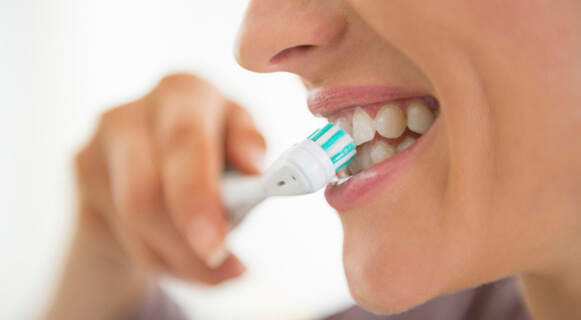
Conduct the proper hygiene of the oral cavity
– wash your teeth behind each meal with a toothbrush and a paste containing fluorine, a toothpick, and rinse the mouth with a mouthwash. What is very important, and many people ignore it, is cleaning up the language. Change your toothbrush every 2-3 months. If you use a dental prosthesis, take it out in the evening, and thoroughly clean it before re-using it in the morning.
TOOTH LOST DURING THE PREGNANCY- TRUE AND FALSE THINGS ABOUT IT
Even though we live in a modern world with all benefits of science in many different areas: from medicine, technology to space science and many others, many people still have doubts and dilemmas regarding their health. Pregnancy is special for every young couple. It turns their world upside-down. Thus it’s understandable since that future parents are afraid and more susceptible to become suspicious about all their knowledge regard health.
There is common belief that each pregnancy leads to at least lost of one tooth. The main reason for this is another mislead: calcium from future mom is used for integration in baby’s bones. This myth called “Tooth lost during pregnancy” is frequently used as an excuse for bad oral hygiene.
So, what we can do to help our teeth and gums stay healthy and beautiful during this period?
Oral healthcare
There are definitely changes in oral status among pregnant women. What is new is that hormonal disbalance is present and it affects gums. Consequently, the blood flow in gums is changed and with a dental plaque, that is normally present in every person regardless is she pregnant or not, there is a greater chance for development of gingivitis. This condition is presented with swollen gums that are red and prone to bleeding during teeth brushing and flossing. Beside that, in pregnancy, there is an increased number of bacteria called Prevotella intermedia that are responsible for the development of gingivitis. When a woman with recently healthy, non-bleeding gums get affected with gingivitis it is absolutely normal that she experience the fear of bleeding, so she starts avoiding teeth brushing. This, of course, leads to worsening of present symptoms.
What can we do?
– proper oral care is crucial! If we avoid brushing properly the symptoms get worse with more inflamed gums that will bleed and hurt more. The main cause of this infection is dental plaque that stays on teeth becoming harder to remove since the gums get more swollen
– brush your teeth at least twice a day
– use soft brushes
– use dental floss or interdental brushes
– use dental liquids with fluorides and avoid liquids with chlorhexidine
Visit your dentist
Many women in a period of pregnancy avoid dental appointments thinking it is not so important to take care of their oral health during pregnancy, but most importantly many of them believe that dental interventions are contraindicated in this period and may hurt the baby in some way. The fear, that is usually unfounded, of anesthesia, potential antibiotics or radiography is the main reason for avoiding dental check-ups in pregnancy.
What can we do?
– Definitely, the best option is that we have regular check-ups even before planning a pregnancy. That way we can be sure that the future mother has healthy teeth and gums. This way the need for potential dental interventions is minimalized and periodic check-ups are just prevention.
– Even if your dentist notices any problem with your oral health during your pregnancy it all can be fixed in a way that both mother and baby stay safe. By making an individual plan for each patient, your dentist will diagnose any problem and discuss the best and the safest way to deal with it and not jeopardize yours or your’s baby health.
– It is important to know that bacterias that causing caries and gingivitis can be transferred to your baby after birth. By visiting your dentist during the period of pregnancy not only you protect your health and your baby’s health, but you can get useful information and instructions for oral health for you and your baby.
Frequent vomiting during pregnancy
Emesis gravidarum or vomiting in a period of pregnancy is usually present in the morning during the first couple of months of pregnancy. This way, teeth get often in contact with strong stomach acid that can damage superficial layer of teeth known as enamel. Acid can literally dissolve enamel and make teeth sensitive to hot or cold drinks or food and even more prone to caries. After vomiting, people usually brush their teeth right away. Since the teeth are damaged by stomach acid, brushing teeth can only make it worse by making greater damage to teeth caused by a mechanical destruction of previously chemically damaged teeth.

What can we do?
– Make sure to brush your teeth right after you wake up and before vomiting. It is important not to brush your teeth right after vomiting. Instead, make the solution of water and Sodium bicarbonate (dissolve one coffee spoon of Sodium bicarbonate in 2 liters of water) and wash out your mouth.
– Make sure you use a soft brush and that you brush all of your teeth equally.
– If your vomiting is more frequent than 3 times per day make an appointment with your physiatrics for a consult.
Healthy diet
It is common misbelief that “Future mom should eat for two persons”. Frequent food intake can be related to teeth loss caused by a greater amount of caries lesions that can not be fixed by conservative or endodontic treatment, especially when it’s associated with poor oral hygiene and without control of dentist. Types of food that are consumed during the pregnancy are of great importance for mother’s general health so as for baby’s health and proper development.
What can we do?
– Consume enough water during the day. Avoid sodas with sugar, fast food, snacks, and candies.
– The balanced diet is the most appropriate. Higher amounts of fresh fruits and vegetables, whole grain bread, milk, cheese, eggs, chicken breasts, and fish should be your first choice.
– Consult your gynecologist regard additional intake of Folinic acid since it’s deficiency can lead to malformation of baby’s upper lip and palate.
Stress
Stress in all conditions and ages has a negative influence on the entire body. It can affect endocrine glands and that way regulate hormones in our body. As a result, the salivation in our mouth can be reduced due to stress. Lack of saliva affects oral bacterial flora in the way that it stimulates their growth. On the other hand, saliva contains many significant components that help us to reduce infections and inflammation in our mouth but also mechanically washes away dental plaque.
With right knowledge of oral health and with regular visits to your dentist there should be no problem with your’s and your baby’s teeth during pregnancy so as after the birth. When you are well informed during regular check-ups your teeth should be healthy before you get pregnant and you can easily keep this status during pregnancy. So, don’t believe the myths. You hold the key to your life’s happiness and health. Use it wise.
Teeth bleaching
Teeth bleaching or teeth whitening is one of the most common cosmetic procedures in dentistry. This procedure provides a better-looking smile and restores the natural shade of your teeth, or even provides a shade that is whiter than your natural one. White teeth are often associated with beauty, so there probably isn’t a single person that wouldn’t like to have a pearly white smile. By removing different stains and discolorations caused by extrinsic or intrinsic factors that can affect your natural teeth color, the whitening procedure will be able to remove the stains and help in improving the teeth’s color. The term teeth bleaching is associated with using bleaching products. Most of the bleaching products are based on hydrogen peroxide or carbamide peroxide.
What can cause a change in the natural color of your teeth?
The enamel is a transparent tooth substance that covers the dentin. The dentin, on the other hand, is a colored substance that has a great importance in determining the natural color of the teeth. The color mainly depends on the color of the dentine and the thickness of the enamel. If the enamel is thinner it allows the dentin color to show through more, and it provides a greater light reflection. But if the enamel is thicker there is less reflection and less exposure of the dentin color. The enamel contains pores in his structure and that is the main reason why different discolorations and stains can happen to the natural teeth color.
There are a lot of internal and external factors that can cause discoloration of the teeth.
• External factors:
The external factors include a lot of things that out teeth come in touch with every day. The most common ones are dark-colored drinks such as tea, red wine, soda, sports drinks, coffee, food, smoking. Another factor that can cause teeth staining is improper oral hygiene. Dental plaque and calculus are very common among people, and the color of the calculus can vary from yellow, grey, brow or even black. The chlorhexidine that is a part of a lot of antiseptic mouthwashes can also be an external factor.
• Internal factors:
The internal factors are a result of a change in the tooth structure. This group of factors includes dental decay, amalgam fillings, dental trauma, antibiotics (tetracycline and minocycline), disorders, fluorosis, dentinogenesis imperfecta, amelogenesis imperfecta, enamel hypoplasia and more.
Age is also a factor that contributes to teeth coloring, as we grow older the enamel becomes thinner and more translucent which allows greater dentine exposure.
Where can you get your teeth whitened?
There are two ways that you can get a brighter smile. The first and safer one is visiting a dentist and getting an in-office treatment. And the second one is using home whitening systems that are usually inexpensive and are becoming more popular every day.
1. In-office bleaching
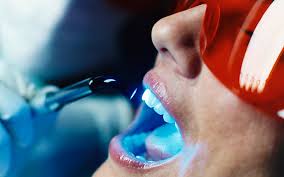 Just like it was mentioned before, this is the safest way to get your teeth whitened. Most of the dentists offer this service in their dental offices. Before getting your teeth whitened the dentist will get information on your medical and dental history, he will do a dental exam and probably will perform a prophylactic cleaning to remove all of the plaque that is present on the surface of the teeth. If there are any tooth decays, cracks or gum conditions, they have to be accessed first before proceeding with the whitening procedure. There are special shade guides that are used to measure the patient’s teeth color before the whitening and to further compare the effects and the results of the procedure. The bleaching can last for a different time and it depends on the results that the patient wants to get and on his lifestyle.
Just like it was mentioned before, this is the safest way to get your teeth whitened. Most of the dentists offer this service in their dental offices. Before getting your teeth whitened the dentist will get information on your medical and dental history, he will do a dental exam and probably will perform a prophylactic cleaning to remove all of the plaque that is present on the surface of the teeth. If there are any tooth decays, cracks or gum conditions, they have to be accessed first before proceeding with the whitening procedure. There are special shade guides that are used to measure the patient’s teeth color before the whitening and to further compare the effects and the results of the procedure. The bleaching can last for a different time and it depends on the results that the patient wants to get and on his lifestyle.
The bleaching agents that are used are based either on hydrogen peroxide or carbamide peroxide. Hydrogen peroxide is almost three times stronger than carbamide peroxide so that is why it is used in solutions that contain 3%-15% hydrogen peroxide, or if the bleaching agents are based on carbamide peroxide they can contain 10%-45% carbamide peroxide. These substances have the ability to penetrate in the structure of the enamel and that is how they dissolve the stains that cause discoloration.
Both vital and non-vital teeth can be treated and bleached.
• Vital whitening:
There are several different methods of in-office vital teeth whitening. All of these methods include placing a bleaching agent on the surface of the teeth. All of the methods last from 30 to 90 minutes, are painless and are always supervised and controlled by a dentist. The number of appointments depends on the shade that the patient wants to get, the severity of the discoloration and the method that is used. Before starting the whitening procedure, the dentist will protect your gums and the papilla by applying a light-cured protective layer or a liquid rubber dam. Other protective materials that are used are also face bibs, gauze, retractors, protective eyewear. All of this protection is needed because the whitening agents can cause damage and irritation of the soft tissues.
Light-accelerated bleaching is one of the most common methods used in the everyday practice. This method uses a bleaching agent and a light energy that can come from LED, halogen or plasma arc lights and it is considered that the light will accelerate the process of whitening. The light energy should accelerate the molecules of the peroxide without causing any damage to the pulp of the tooth and causing hypersensitivity.
A lot of dentists prefer not to use any light to activate the bleaching gel. There are a lot of researches that show that the bleaching systems work the same with and without being activated by light. The procedure lasts from 30 to 90 minutes, depending on the product that is used. Once the bleaching gel is applied the procedure can be divided in more cycles, and after every cycle the gel is rinsed off the teeth and a fresh gel is applied. The whole procedure can be carried out in one cycle, where the doctor only adds more bleaching gel.
Laser teeth whitening is probably the most expensive whitening procedure at the moment. This procedure also includes applying a bleaching gel that contains hydrogen peroxide or carbamide peroxide, and the gel is activated and heated by a laser.
• Non-vital bleaching
The non-vital or internal method is used for teeth that have previously had an endodontic treatment or also known as root canal treatment. These teeth have internal stains from blood or other liquids that have colored them during the treatment or after it. With these types of stains, the external methods of bleaching are not successful. The procedure starts by properly cleaning and filling the root canals. After that the dentist places a whitening agent inside the pulp chamber and seals the tooth with a temporary filling over the whitening product. The whitening product has to be replaced a couple of times depending on the case. This method is commonly known as the “walking bleach” method.
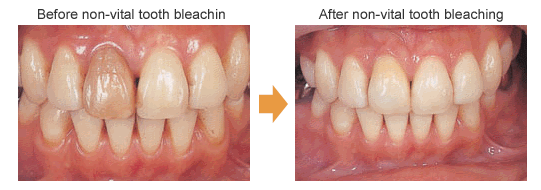
Another option for devitalized teeth is placing a bleaching agent in the pulp chamber, but the cavity is left open, and it is combined with external bleaching of the tooth.
The in-office method of teeth bleaching is recommended because it is the safest way in getting your teeth whitened, the dentists are highly-professional and trained in preventing any risks and complications.
2. Home whitening systems
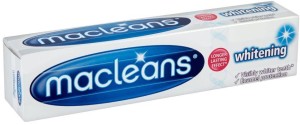 After your visit at the dentist’s office and after the treatment, the dentist might also provide you with a home whitening system for you to use. He will first take impressions of your teeth and provide you with mouthpiece trays that are made based on those impressions. You will also be given a whitening gel. The doctor will give you clear instructions on how to use the whitening system, for how long and how many times a day.
After your visit at the dentist’s office and after the treatment, the dentist might also provide you with a home whitening system for you to use. He will first take impressions of your teeth and provide you with mouthpiece trays that are made based on those impressions. You will also be given a whitening gel. The doctor will give you clear instructions on how to use the whitening system, for how long and how many times a day.
There are also a lot of available whitening products over the counter. These products are available as whitening toothpaste, whitening strips, mouth trays, whitening gums, paint-on whiteners, rinses and more. All of these products contain bleaching agents, but much less than the whitening agents that are used for in-office whitening. They come with instructions on how to use them to avoid any risks and complications.
Positive effects
The latest bleaching agents include fluoride in their ingredients, which helps with hypersensitivity and increasing the enamel hardness. The fluoride combined with potassium nitrate are a great improvement in the quality of the bleaching agents because they offer a whitening process which is more comfortable for patients, relief from sensitivity and improved oral health. Ultradent is the first company that presented this technology, and their products do not need to be activated by light and are widely used around the world.
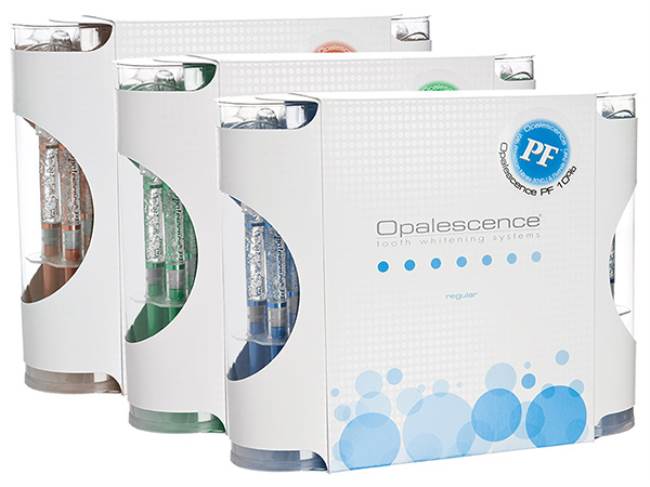
Risks
Some patients might experience hypersensitivity after their bleaching treatment. This is usually only a temporary complication and it happens in the first couple of bleaching treatments. This hypersensitivity is caused by the bleaching agent, that has a very low pH, that causes the dentin tubules to open up and make them very sensitive to thermal changes. Also light activated teeth whitening is considered to increase the risk of post whitening sensitivity, mostly because of the heat that is produced. This heat affects the liquid in the dentin tubules and causes dehydration and sensitivity. To avoid hypersensitivity, the best way to get whiter teeth is to visit a dentist’s office. If there is sensitivity present, the bleaching treatments should stop and those patients can use special toothpaste that can ease the discomfort.
Another thing that might happen after the bleaching procedure is to get uneven results. The teeth might be more stained in some areas compared to others. Also in order to prevent uneven staining patients need to avoid certain drinks and food that might color the teeth after a bleaching treatment.
Over-bleaching can happen to people that use bleaching products very intensively. This can cause damage to the teeth’s substances and change their color to overly white and very translucent.
There are some bleaching products that can cause damage to the enamel, especially if they are not used according to the instructions.
The hydrogen peroxide and carbamide peroxide that are used during the bleaching are caustic substances and if they are not used properly they can cause damage and irritation to gums and oral tissues. If the tissues are not protected properly during the whitening, the bleaching agents can cause burns to the oral mucosa, and patients will feel burning sensation. Over the counter mouth trays are not custom made for every individual, so they are one of the most common reasons for tissue damage. This is why it is very important for teeth bleaching to be supervised by a professional.
Some people can get addicted to this procedure, and keep visiting the dentist or keep using at-home bleaching systems, even though their teeth are white enough. This condition is known as bleachorexia.
How long will your teeth stay white?
The teeth whitening procedure does not provide permanent results. Your teeth will get stained again with food, drinks, tobacco and more. If you can avoid drinking colored drinks, smoking and certain types of food the results of the procedure will last much longer. The results vary from patient to patient, but they usually need another treatment after six months or a year. If you want to maintain the results of the treatment as long as possible you have to brush your teeth and rinse after eating of drinking, you can use a whitening toothpaste, floss regularly, and avoid drinking beverages and eating food that can stain your teeth.
Who should avoid teeth bleaching?
People that already have sensitive teeth and gums, pregnant women, children under 16, people with gingival recession, people that have defective restorations and more should avoid this type of treatment. Another thing both patients and dentists have to take care of is teeth damaged by a cavity. Untreated decay should first be properly removed and treated with a filling before the bleaching procedure. The main reason behind this is that the bleaching agents can reach to the dental pulp and cause further damage.
Six Worst Foods For Your Teeth
Eating properly is of great importance for the health of your teeth. There are many types of food that you eat on daily basis and you are not aware of the harm they are doing for you. Literally, every harmful food will show the negative effect first on your teeth and later on other parts of your body. Caries is a chronic disease that affects the teeth and their hard tissues. It all starts with bacteria that use the food that you eat as their own. For example, most bacteria enjoy sugar and they transform it into acids. Those acids affect your enamel and that is how caries happens. From then on, it spreads into the dentin and it can even affect the dental pulp. This is just one of the reasons why you should know which types of food are harmful to your teeth. Also, some drinks can have damaging effects, and those should be excluded from your diet too.
Candy

All types of candies that you enjoy are bad for your teeth. This is probably bad news for you, but it is time to forget about candy. For example, sour candy is very chewy and can really stick to your teeth. You will find it very hard to remove them and during that time they can cause a lot of damage. Also, sour candy releases many kinds of acids that harm the hard tooth tissues. All other types of chewy candy is a bad idea for the same reason. They stay on your teeth for a long time and are a dangerous and unhealthy snack. Hard candies, on the other hand, don’t really stick to your teeth. But, unfortunately, they are also bad for your smile. It takes quite a while for them to dissolve in your mouth, and that is a great way for bacteria to enjoy all the sugars that are being released. Plus, there are people that want to bite down on these candies, which can lead to broken and chipped teeth. There are many downsides to eating candy, so now you know why you have to quit them.
Citrus Fruits

All types of citrus fruits can cause damage to your smile. They might be very good for your general health but they are not good at all for your teeth. Oranges, lemons, grapefruits all contain large doses of Vitamin C. In other words, those are acids that can cause erosion of your teeth. Lemon and pomegranate juice are unfortunately the worst for the health of your smile. They are the fruits that are literally packed with Vitamin C. Orange juice, on the other hand, is less acidic. Since you can’t always avoid citrus fruits you should only eat and drink them from time to time. After that, make sure to rinse your mouth with water.
Crunchy Snacks

All of the crunchy snacks such as potato chips are packed with starch. That is an ingredient that has the tendency to stick to your teeth and get trapped in the places between your teeth. It is really hard to completely remove food from those places and it ends up being transformed in plaque. Harmful bacteria use the starch as their own food. Plaque build-up leads to caries and periodontal disease. That is why when you finish a bag of chips you should brush your teeth and floss to avoid these conditions.
Dried and Canned Fruit
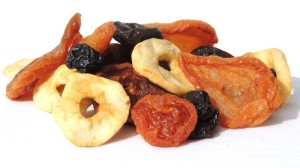
While dried fruit is a healthy way to get your snack, it is not good for your smile. The first thing you will notice is that they are very sticky. Dried grapes, apricots, plums can really be delicious, but it takes quite a while to chew them and half of that stays stuck in your teeth. Another huge problem is that they are made of sugar. A large part of their content is natural sugar that is a great food for bacteria. If you really love eating dry fruits, you should at least rinse your mouth with water after that. The better alternative is to switch to natural fruits.
Canned fruits contain much more sugar compared to any other type. They are also packed with it and that makes them very bad for teeth. They are also not healthy and you should avoid them at all costs.
Bread

A lot of people can’t imagine having a meal without bread. The thing is that white bread is packed with refined carbohydrates. When you eat bread the saliva transforms the starch into carbohydrates that can get stuck between your teeth. That is where they become the food of bacteria and lead to plaque build-up. That is the reason why you should switch to whole wheat bread.
Pickles

The main problem with pickles is that they contain a lot of acids. Just by eating them you expose your teeth to erosion. That same acid is what makes the pickles taste sour. But it also damages the enamel and it can cause caries. We are not saying that you should avoid eating pickles at all costs, just be careful not to overdo it. Right after you finish eating it is a good idea that you rinse with water.
All of these types of food can cause a lot of damage to your smile, especially if you eat them on daily basis. You have to be very careful when it comes to your diet. Eating them from time to time shouldn’t be dangerous. It only becomes bad if you tend to enjoy chips and candy, for example, every single day. Proper oral hygiene is another thing that you have to take care of. Regular brushing and flossing will remove all food remains are there will be nothing left for bacteria to feed on. When you eat highly-acidic foods you shouldn’t brush your teeth right away since you can make the enamel even more vulnerable. All you need to do is rinse with water. Regular dental check-ups are a must.





